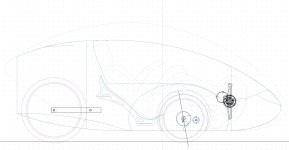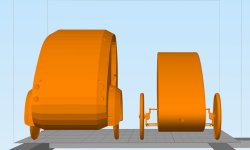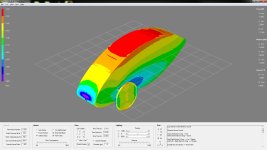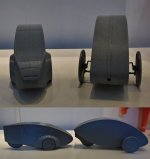At such a steep viewing angle I wonder how well the windshield is going to work. That's a similar shape to what I had in mind for my current build, but with not such a long tail. more planes and less convexed parts are for sure much easier to build. Wood again?
You are using an out of date browser. It may not display this or other websites correctly.
You should upgrade or use an alternative browser.
You should upgrade or use an alternative browser.
Project: Home made velomobile design with crank or mid motor
- Thread starter tahustvedt
- Start date
At such a steep viewing angle I wonder how well the windshield is going to work. That's a similar shape to what I had in mind for my current build, but with not such a long tail. more planes and less convexed parts are for sure much easier to build or lay out carbon or fiberglass. Wood again?
Are you moving on to the new body before finishing the pneumatic leaning?
Are you moving on to the new body before finishing the pneumatic leaning?
tahustvedt
10 kW
I will probably just start on the new one before making the pneumatic stuff. I have all the parts I need for the pneumatics, but lost interest.
The attached drawing shows the new vs the old outline. I think the windshield will be fine. I can see forward out the side windows of my old velo.
The other picture shows my old velo compared to the Organic Transit Elf model I made. I had to correct the height and length of the Elf body because it was too small before. It's pretty big.
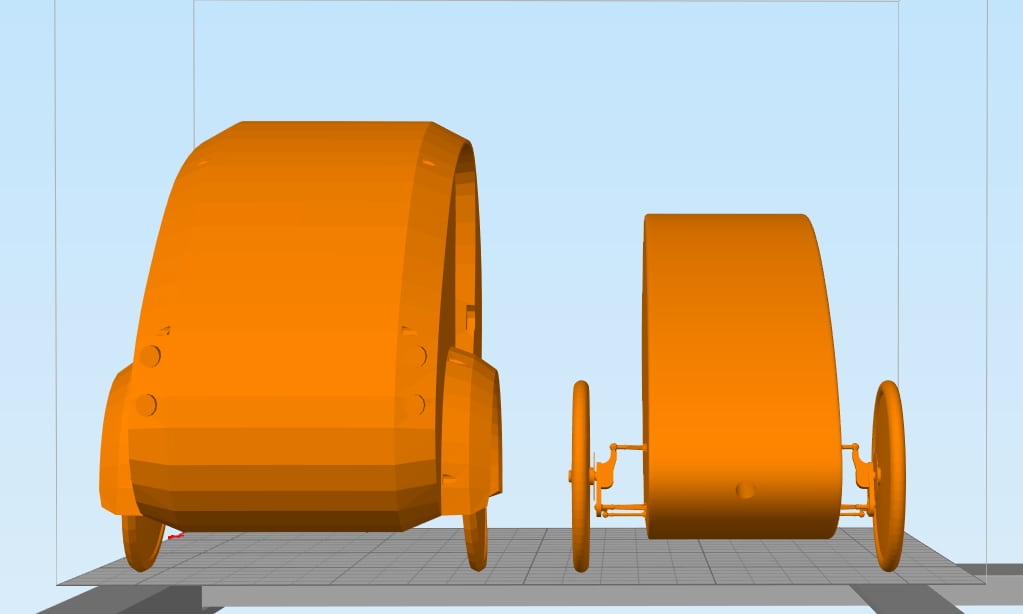
The attached drawing shows the new vs the old outline. I think the windshield will be fine. I can see forward out the side windows of my old velo.
The other picture shows my old velo compared to the Organic Transit Elf model I made. I had to correct the height and length of the Elf body because it was too small before. It's pretty big.
Attachments
tahustvedt
10 kW
I thought the drag from the old tests were way too high compared to how it felt so I ran a new test with an updated model. 341 W @ 40 km/h. This is close to how it feels to pedal at 40. I have two bikes with power meters so I have a lot of experience with reading my power output. Oh, and guess what the Elf model requires at 40 km/h. 
The downforce is way lower than before, and the exposed wheels and suspension are the main reason for all the drag. I will run a test with a small spoiler under the tail to see what happens. I will also run tests with faired suspension arms and wheels.
The downforce is way lower than before, and the exposed wheels and suspension are the main reason for all the drag. I will run a test with a small spoiler under the tail to see what happens. I will also run tests with faired suspension arms and wheels.
Attachments
--freeride--
100 W
- Joined
- Jul 5, 2011
- Messages
- 237
I would guess the Elf takes 600W for 40km/h
tahustvedt
10 kW
My Elf model takes 845 W aerodynamically at 40 km/h.
The Quest model takes 117 W.
The Quest model takes 117 W.
Wheazel
10 kW
tahustvedt said:Turns out the boxy profile is the best. 140 W at 40 km/h is pretty good. It has the best visibility and is easier to build as well.
Wow I would not have guessed that the boxy one would be more slick then the tapered one.
140W vs 341W blows my mind. This is what you should have known prior to build nr 1
Drag increases with the square of the velocity. so if you cut the frontal cross section area in half you will experience roughly 4 times less drag. Of course this is oversimplifying it because the 3 dimensional shape has just as much to do with it but the difference in frontal area plays just as much a role.
--freeride--
100 W
- Joined
- Jul 5, 2011
- Messages
- 237
The Elf will even be worth, because there are no side Windows ...
tahustvedt
10 kW
Drag increases square with the velocity, but not square with changes in frontal area. 
My Elf 3D model has no side doors, so it does take in account the extra drag of pulling along a second frontal area f the rear of the cabin. It's not a perfectly accurate model if the Elf, but it does give a ballpark figure. I asked Organic Transit what the drag was at 20 mph but they just said the Cd was 0,32, which doesn't say anything about the drag. They are hung up on Cd. The giant openings on the sides means the frontal area is alomst double of the actual frontal area. Their aerodynamic CFD report says closing the floor and doors increased Cd, but that's not important. I bet it reduced the drag considerably.
My Elf 3D model has no side doors, so it does take in account the extra drag of pulling along a second frontal area f the rear of the cabin. It's not a perfectly accurate model if the Elf, but it does give a ballpark figure. I asked Organic Transit what the drag was at 20 mph but they just said the Cd was 0,32, which doesn't say anything about the drag. They are hung up on Cd. The giant openings on the sides means the frontal area is alomst double of the actual frontal area. Their aerodynamic CFD report says closing the floor and doors increased Cd, but that's not important. I bet it reduced the drag considerably.
tahustvedt
10 kW
I ran a test with a tiny spoiler under the tail last night. It reduced the drag by 3 W. Not significant. I'll try with fairings over the suspension arms next.
tahustvedt
10 kW
On the highest stability setting it usually takes 7 hour 30 minutes to complete. It'll be faster if you have a CUDA graphics adapter with more than 1,5 GB ram.
2x GTX 980TI in SLI. It's only using 1 GPU though. A progress bar would be nice. Just hangs the application with no indication of whether or not is stuck in a loop. Awesome application, though. This kind of testing ability makes me care a little more about aerodynamic design. If this is a more powerful GPU than what you have you can always email me your .STL binary to run a test for you.
tahustvedt
10 kW
I run at night. Wish it had batch running though so that I could run several simulations. Tonight I'm going to run a slightly more refined model of my new velomobile.
tahustvedt
10 kW
I'm starting to really like this shape.
recumpence
1 GW
Wow, beautiful.
Matt
Matt
tahustvedt
10 kW
Wheazel
10 kW
Very nice, there are some distinct differences here. What I can see from the models: Lower design, narrower body, and much narrower wheelbase.
I have some questions regarding this.
Did you have a lot of unused space in the current design?
Changes in turning radius old vs new?
How wide is the new design one? Narrow enough to require tilting for stability? (as my upright tilting wintertrike does that is 50cm track width)
Any changes in seating/handlebar positions? Other ergonomics?
Such a cool concept!
I have some questions regarding this.
Did you have a lot of unused space in the current design?
Changes in turning radius old vs new?
How wide is the new design one? Narrow enough to require tilting for stability? (as my upright tilting wintertrike does that is 50cm track width)
Any changes in seating/handlebar positions? Other ergonomics?
Such a cool concept!
tahustvedt
10 kW
The old one is a bit oversize. Something that is really hard to discover on a computer screen. the internal width and height is enough for a very large person, which I am not. Turning radius will be adequate. The track is wider than other fast velomobiles, at 720 mm, but the CG will also abe a bit higher for comfort and clearance to the fwd drive train. The Milan for example has a 585 mm track. It will not have tilting. Most other velomobiles can roll over if you turn too hard. You're asking about a lot of things that aren't 100% set.  I haven't finished designing it. It will probably have tank-steering, like the Milan velomobile.
I haven't finished designing it. It will probably have tank-steering, like the Milan velomobile.
Wheazel
10 kW
Did you settle on how to open it up?
tahustvedt
10 kW
Probably hinged in the front. I hope I can make it rigid enough to not flop about too much. It will have some carbon fiber tubing structure where the round shape is in the middle of the canopy. a 50 mm diameter tube across inside. I plan to mount mirrors on the outside there and the GPS mount onthe round carbon tube inside.
The Toecutter
100 kW
- Joined
- Feb 8, 2015
- Messages
- 1,478
That is a beautiful design.
Were you to sell kits, I might be inclined to buy one. This should allow significantly faster cruising than your upright bike on flat ground. It is the shape that the designers of the ELF should have thought of instead of that drag-inducing mess they came up with. This is a vehicle shape that is strong, practical, relatively uncomplicated, AND efficient.
I'm not sure an occupant would tolerate a Texas summer in it, but for your climate and wintertime use, it will work well.
Were you to sell kits, I might be inclined to buy one. This should allow significantly faster cruising than your upright bike on flat ground. It is the shape that the designers of the ELF should have thought of instead of that drag-inducing mess they came up with. This is a vehicle shape that is strong, practical, relatively uncomplicated, AND efficient.
I'm not sure an occupant would tolerate a Texas summer in it, but for your climate and wintertime use, it will work well.
It's important to recognize that the ELF wasn't shooting for efficiency. They were trying to market to the masses with a design that the non bike rider could see themselves driving to work. Something someone, when glancing at it wouldn't say "there's no way i can get in that." It has a chair with a simple door that invites them in. They manage to sell those things to people for the price of a new budget priced car.
Are you going with a monocoque again? Are you saying the paneling is going to be the exterior body, the routered structure, or both?
Are you going with a monocoque again? Are you saying the paneling is going to be the exterior body, the routered structure, or both?
Similar threads
- Replies
- 12
- Views
- 704
- Replies
- 12
- Views
- 2,174
- Replies
- 11
- Views
- 318
- Replies
- 23
- Views
- 879


